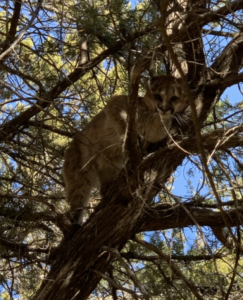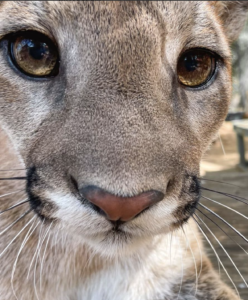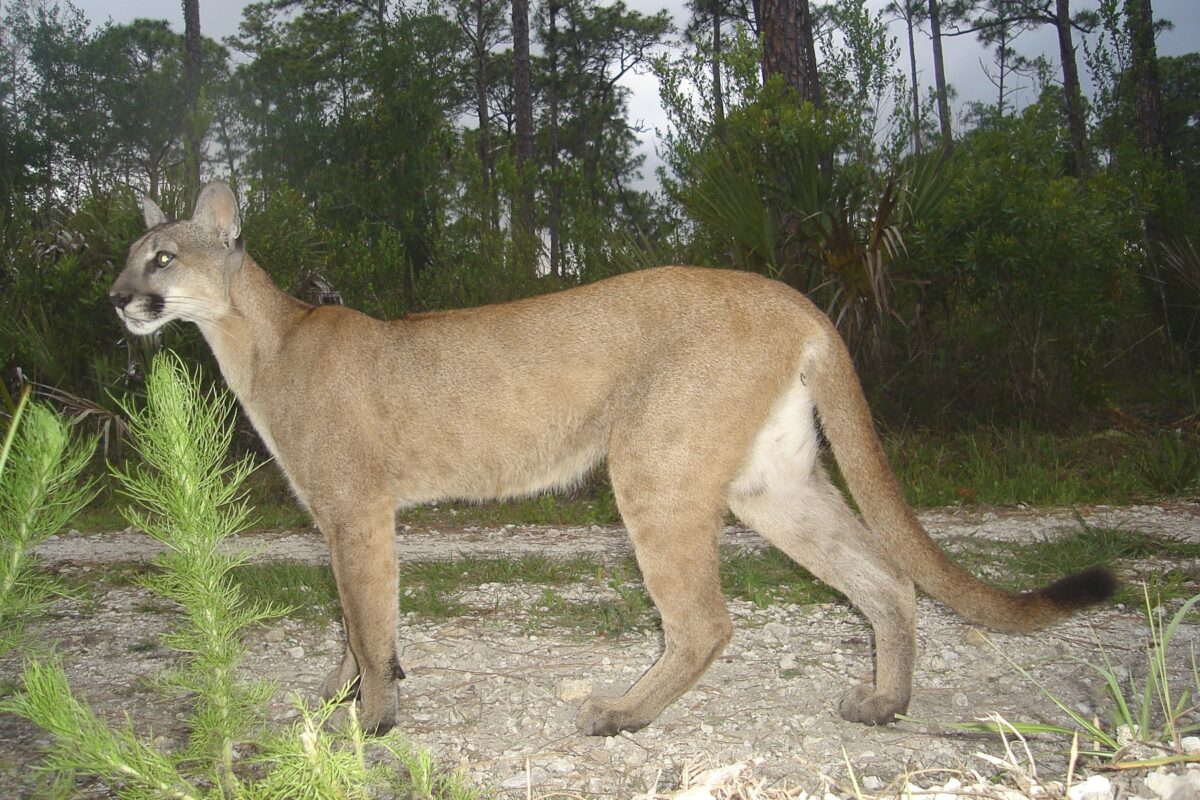The Mountain Lion Minutes are a monthly blog authored by Zack Curcija, an Arizona-based volunteer with the Mountain Lion Foundation.
The Consequences of Sport Hunting: Orphaned Kittens
A gunshot pierces the crisp December air in a central Arizona mountain range, temporarily halting the cacophony of baying hounds. A female mountain lion – a queen – is dead. She was not destroyed for committing depredations on the cattle that graze the nearby valleys. She was not posing any threat to the humans who pursued and killed her for sport. She was also not a solitary cat: A litter of approximately four-month-old kittens awaits her return.
How many kittens comprised the litter will remain a mystery, though it is probable the slain female – like the average mountain lion mother – had between two and four kittens. Young kittens are entirely dependent on their mother for nutrition and protection, and – once orphaned – are destined to die of starvation, exposure, or predation on their own. This is the presumed fate for all but one of the litter, a remarkable female kitten who emerged from her mountain stronghold nearly one month after the death of her mother. Lured to an idyllic homestead by the sound of clucking chickens, the kitten ventured to the same trailhead where the hunters who killed her mother initiated their chase.

A benevolent rancher discovered the emaciated kitten clawing at a chicken coop in a desperate attempt to satiate weeks of hunger. At the recommendation of the Arizona Game and Fish Department (AZGFD), the kitten was captured and rescued by the Southwest Wildlife Conservation Center, where she was rehabilitated back to health and given the name Poppy. There she will spend the remainder of her life among other mountain lions with similar backstories. Though her growth was stunted from the malnutrition she suffered at an early age, Poppy retains the vigor that saw her through her time as an orphan, and she enjoys roughhousing with her older – and much larger – foster siblings.
Poppy is emblematic of a common but typically invisible repercussion of mountain lion hunting. While the recreational harvest of spotted kittens or females with spotted kittens is unlawful in Arizona, young kittens are rarely travelling with their mothers when the latter are pursued by hunters and their hounds. Aiming to reduce the number of kittens orphaned each hunting season, AZGFD recently implemented a seasonal closure between June 1st and August 20th of each year to accommodate a portion of the seasonal birth pulse when most kittens are born (AZGFD 2021a). A seasonal closure – in principle – offers a window for dependent kittens born during the birth pulse to physically develop and begin travelling with their mothers, therefore making family groups more identifiable to hunters when the season reopens.
However, the brief recess – in practice – only benefits a small minority of kittens born during the earliest stage of the closure, which itself represents a fraction of the seasonal birth pulse observed in North American mountain lions. Though female mountain lions can birth litters at any time throughout the year, North Americas mountain lions exhibit a seasonal birth pulse between May and October, during which more than 70% of annual births take place (Laudré and Hernández 2007; Logan and Sweanor 2009). For the first six weeks of life, a period known as the “denning” life stage, mountain lion kittens are mostly sedentary and therefore especially vulnerable to orphanage while their mother frequently travels alone. As kittens mature, the probability they will be found travelling with their mother increases continuously until they disperse to establish their own territory as independent subadults between 12 and 24 months of age (O’malley et al. 2018).
Most of the studies that support the birth pulse phenomenon are from northern latitudes. An Arizona study revealed a possible delayed birth pulse, which may reflect an adaptation to extreme summer heat and aridity. Most kittens in the study area were born in August, October, and December, suggesting there is minimal overlap between when most kittens are born and the seasonal closure that occurs when temperatures are high and historic levels of hunting were already relatively low (Wakeling et al. 2015; Zornes et al. 2006).
To confer sufficient protection to most mountain lion mothers and their dependent kittens, a seasonal closure must accommodate a greater portion of the mountain lion birth pulse. Research conducted by Panthera found that the overwhelming majority of mountain lion kittens born in a given year complete their denning stage and are capable of travelling with their mothers by December 1st. The biologists reveal that extending a seasonal closure from June 1st through November 1st would accommodate the denning period of 85% of mountain lion family groups that include dependent kittens, while delaying the season until December 1st would accommodate the denning period for 91% of litters (O’malley et al. 2018).
At nearly nine and half months long, the hunting season for mountain lion is conspicuously longer than that of any other big game species in Arizona (AZGFD 2021b). A seasonal closure from June 1st through December 1st would still allow for six months of hunting opportunities while improving the detectability of most mountain lion family groups on the landscape. Extending the seasonal closure to overlap with the hunting seasons of other game species is also important to mitigate the type of hunting that most adversely affects female mountain lions. AZGFD data show that hunters targeting other game species while opportunistically carrying a mountain lion tag are less selective if they encounter a mountain lion. Opportunistic hunters disproportionately shoot females compared hound hunters who generally seek larger trophy males and can often get close enough to – with the appropriate knowledge – identify sex and approximate age (Zornes et al. 2006; AZGFD 2021a).

While orphaned kittens are an inevitable consequence of hunting female mountain lions, AZGFD possesses the knowledge and the ability to offer greater protection to female mountain lions and their dependent kittens through an extended seasonal closure and other measures such as reducing female harvest thresholds and implementing mandatory mountain lion sex identification training for hunters. AZGFD was instrumental in mediating Poppy’s rescue, and as an agency expressly committed to applying knowledge generated through rigorous conservation research, fostering ecological sustainability, and upholding hunting ethics, they should be receptive to sound recommendations that embody all three desirable features of modern hunting.
Hunting induced kitten orphanage is an additive source of predictable mortality that occurs each year as a function of annual hunting rates. Though precisely quantifying the number of kittens orphaned each year through sport hunting is not possible at the state or national level, estimates can be calculated from hunter harvest and mountain lion life history data. The following estimates use numbers published exclusively by AZGFD, and analogous data should be available in other states where mountain lions are managed as a game species. In 2021, hunters killed and reported 118 female mountain lions across Arizona. Age-specific information is not available at this time, and it is likely that at least some of these females were younger than reproductive age (less than 1.5 to 2.5 years old). Therefore, these calculations might slightly overestimate the number of orphaned kittens if some of the females harvested last year were themselves kittens or juveniles. The agency reports that 75% of reproductively mature females are caring for depending offspring at any time, with the majority of mountain lion mothers caring for kittens born during the current year. If 75% of the 118 female lions killed had an average of three kittens, then Poppy was one of approximately 267 mountain lion kittens orphaned by hunting in Arizona in 2020 (AZGFD 2021c; AZGFD 2021d).
Not every kitten dies as a result of being orphaned and not every kitten with a mother survives to adulthood, but the kittens that were orphaned and died because of hunting would otherwise have competed within the arena of natural selection where their survival or death would influence mountain lion population health. AZGFD reports that the survival of orphaned kittens is significantly lower than the survival rate of kittens with a mother: Kittens older than six months have a 71% chance of survival once orphaned compared to a 95% survival rate in kittens with their mother, while kittens younger than six months have a 4% chance of survival as an orphan compared to a 66% survival rate in kittens with their mother (AZGFD 2021d). In reality, kitten survival rates exist on spectrum such that the probability of survival increases exponentially with age. The broad age categories outlined by AZGFD likely yield an overestimation of kitten survival since the survival rate of an orphaned seven-month-old kitten will be closer to the survival rate of an orphaned five-month-old kitten than that of an orphaned eleven-month-old kitten.
Making the conservative assumption that the age classes of orphaned kittens are neatly arranged into thirds (one third of the kittens are less than six months old, one third are between six months and a year old, and one third are over one year old and almost ready for dispersal), calculations based on AZGFD data suggest that around 137 orphaned mountain lion kittens died as a consequence of sport hunting in Arizona in 2020. Had this cohort of misfortunate mountain lion mothers survived to raise their litters, they would have collectively lost roughly 38 kittens to natural sources of mortality. Therefore, in 2020, sport hunting in Arizona resulted in the death of approximately 99 mountain lion kittens that would have otherwise survived to dispersal, adulthood, and reproductive viability.
The story of Poppy the mountain lion kitten represents the disproportionate impact of killing a female mountain lion with dependent kittens: How – in an instant – a single gunshot destroyed two generations of female mountain lions, and removed all possibility of Poppy growing to become a progenitor of her species in the wild. She lived for nearly a month as an orphan, weathering winter storms and frigid nighttime temperatures, evading predators, securing water, and likely outlasting her siblings before being mercifully rescued on the brink of death.
Most young kittens in her situation perish in obscurity, but Poppy may shine as an ambassador of future generations of mountain lion kittens vulnerable to orphanage without added protection. Her story compels us to question whether hunting induced kitten orphanage must remain an unfortunate reality, and recent conservation research suggests the current magnitude of these unintended collateral effects is reducible with ethical management strategies that consider mountain lion life history.
References Cited:
Arizona Game and Fish Department (a) (2021) Mountain Lion Fact Sheet: Understanding Mountain Lion Management in Arizona. https://azgfd-portal-wordpress-pantheon.s3.amazonaws.com/wp-content/uploads/archive/Understanding-Mountain-Lion-ManagementAZ10-6-17.pdf
(b) (2021) 2021-2022 Arizona Hunting Regulations. https://azgfd-portal-wordpress-pantheon.s3.us-west-2.amazonaws.com/wp-content/uploads/archive/2021-22-Arizona-Hunting-Regulations_211012.pdf
(c) 2020 Arizona Mountain Lion Harvest Summary. https://azgfd-portal-wordpress-pantheon.s3.us-west-2.amazonaws.com/wp-content/uploads/archive/2020-AZ-Mountain-Lion-Harvest-Summary.pdf
(d) Mountain Lion Identification and Methods of Determining Sex. https://azgfd-portal-wordpress-pantheon.s3.us-west-2.amazonaws.com/wp-content/uploads/archive/Mountain-Lion-ID-Methods-of-Determining-Sex-and-Age.pdf
Laundré, J. and Hernández, L. (2007) Do Female Pumas (Puma concolor) Exhibit a Birth Pulse?, Journal of Mammalogy, 88(5), 1300–1304, https://doi.org/10.1644/06-MAMM-A-296R.1
Logan, K., & Sweanor, L. (2009). Behavior and social organization of a solitary carnivore. In M. Hornocker & S. Negri (Eds), Cougar: Conservation and Ecology (p. 105-117). Chicago, IL: The University of Chicago Press.
O’malley, C., Elbroch, L.M., Kusler, A., Peziol, M. and Quigley, H. (2018), Aligning mountain lion hunting seasons to mitigate orphaning dependent kittens. Wildl. Soc. Bull., 42: 438-443. https://doi.org/10.1002/wsb.902
Wakeling, B., Day, R., Munig, A., and Childs, J. (2015) Age and Sex Composition of Harvest and Timing of Birth Frequency for Arizona Mountain Lions. In L. Huenneke, C. Van Riper, and K. Hays‐Gilpin (Eds). The Colorado Plateau VI: science and management at the landscape scale (p. 95-101). University of Arizona Press, Tucson. https://doi.org/10.2307/j.ctt183pc7f
Zornes, M., S. Barber, and B. Wakeling (2006) Harvest methods and hunter selectivity of mountain lions in Arizona. In J. Cain III and P. Krausman (Eds). Managing wildlife in the southwest (p.85-89). Southwest Section of the Wildlife Society, Tucson. https://bri.sulross.edu/pubs/proceedings/Southwest2006_sm.pdf



 Facebook
Facebook Twitter
Twitter Send Email
Send Email


